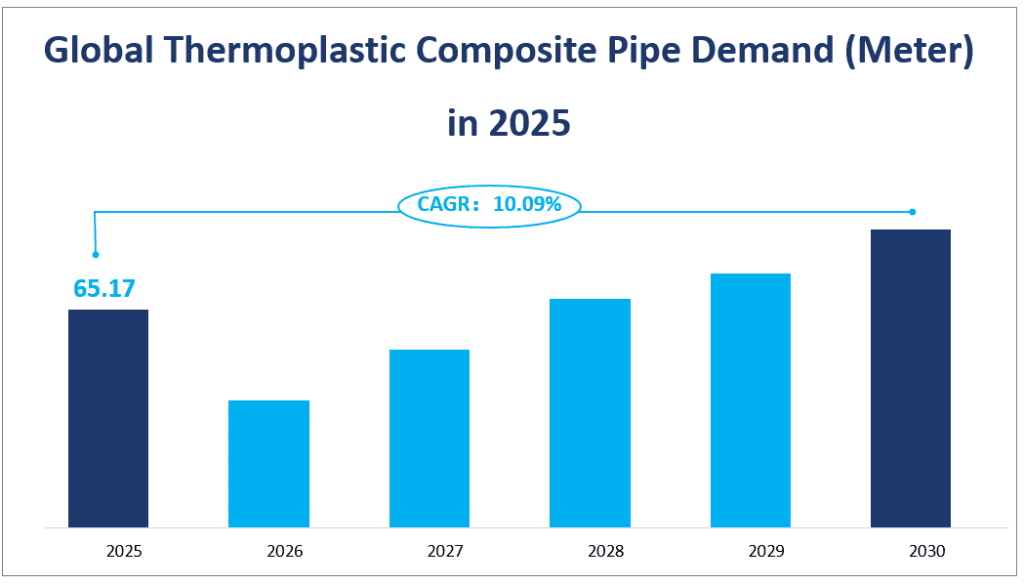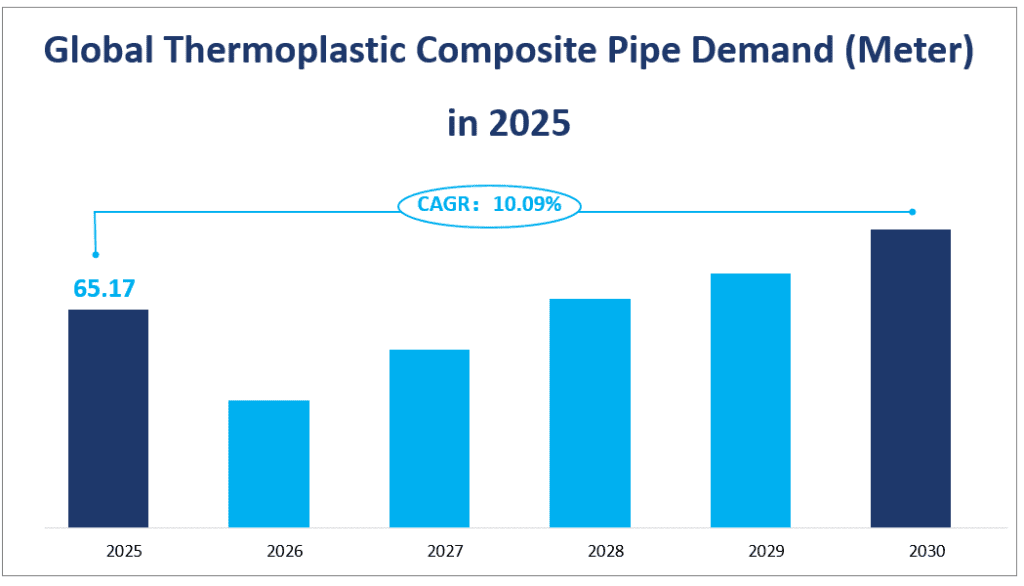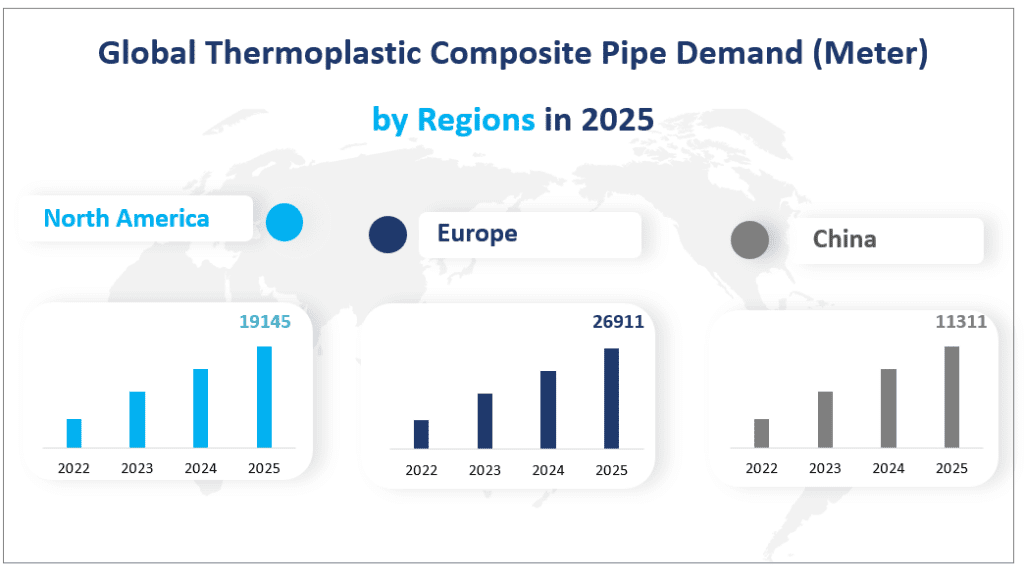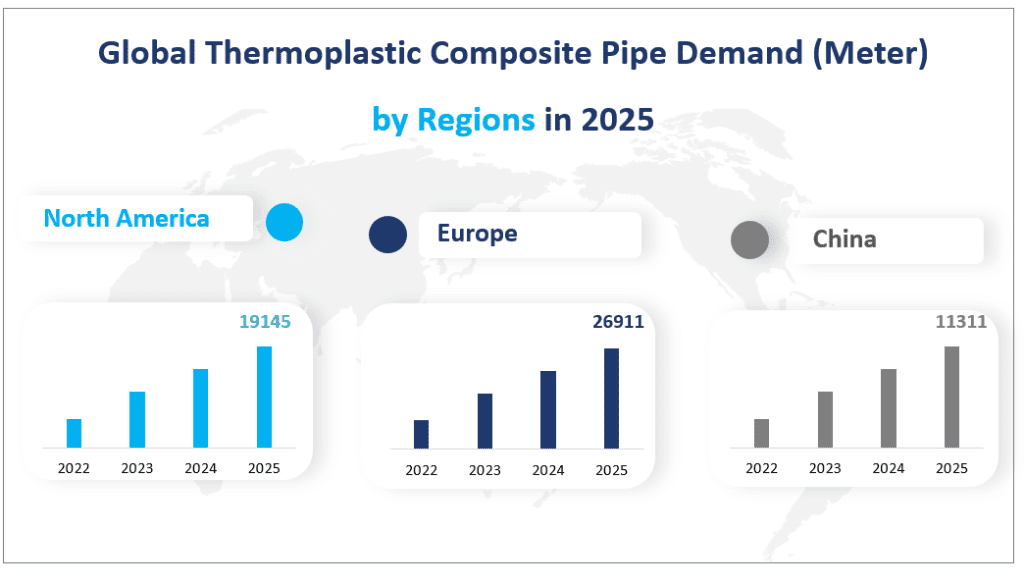1. Global Thermoplastic Composite Pipe Market Overview
The global Thermoplastic Composite Pipe market is projected to reach a revenue of $65.17 million in 2025 with a CAGR of 10.09% from 2025 to 2030, indicating a steady expansion of the market over the next few years.
Thermoplastic Composite Pipe represents a revolutionary advancement in pipeline technology, designed to overcome the limitations of traditional steel and flexible pipes. TCP utilizes thermoplastic composite materials to provide superior strength, flexibility, and corrosion resistance. Unlike traditional steel pipes, which are prone to corrosion and fatigue, TCP offers a lightweight, durable, and cost-effective solution for various industrial applications. The pipes are fully bonded and spoolable, consisting of a polymeric inner liner, fiber-reinforced polymeric laminate, and an outer jacket. This unique structure allows TCP to withstand high pressures and temperatures while maintaining excellent flow characteristics due to its smooth bore.
Global Thermoplastic Composite Pipe Market Demand (Meter) in 2025


2. Driving Factors of Thermoplastic Composite Pipe Market
Firstly, the increasing demand for corrosion-resistant materials in the oil and gas industry is a major driver. Traditional steel pipes are susceptible to corrosion, especially in harsh offshore environments, leading to frequent maintenance and replacements. TCP, with its superior corrosion resistance, offers a long-lasting and cost-effective solution, making it an attractive alternative for operators.
Secondly, the growing focus on reducing operational costs and improving efficiency is another significant driver. TCP’s lightweight nature allows for easier installation and transportation, reducing the need for heavy machinery and lowering overall project costs. Additionally, the material’s flexibility enables it to be coiled and transported in long lengths, minimizing the number of joints and reducing the risk of leaks.
Thirdly, the increasing adoption of TCP in emerging markets is also contributing to the market’s growth. As countries in Asia-Pacific and Latin America continue to develop their oil and gas infrastructure, the demand for advanced pipeline materials is rising. TCP’s ability to handle high pressures and temperatures makes it suitable for deepwater and ultra-deepwater applications, which are becoming more prevalent in these regions.
3. Limiting Factors of Thermoplastic Composite Pipe Market
Despite its numerous advantages, the Thermoplastic Composite Pipe market faces several challenges that could limit its growth. One of the primary challenges is the high initial cost of TCP compared to traditional steel pipes. While TCP offers long-term cost savings through reduced maintenance and operational efficiency, the higher upfront investment may deter some operators, especially in cost-sensitive markets.
Another limiting factor is the intense competition within the Thermoplastic Composite Pipe market. The TCP market is dominated by a few major players, such as Strohm and Magma Global, which control a significant share of the market. New entrants face significant barriers to entry, including high research and development costs, the need for specialized manufacturing capabilities, and the challenge of establishing a strong market presence.
Finally, fluctuations in raw material prices can also impact the market. TCP’s production relies on high-quality polymers and fibers, the prices of which can be volatile due to market conditions and supply chain disruptions. This volatility can affect the production costs and profitability of TCP manufacturers, potentially limiting Thermoplastic Composite Pipe market expansion.
4. Analysis of the Thermoplastic Composite Pipe Market Segment
Product Types
The global TCP market is categorized into four main product types: Polyethylene (PE), Polyvinylidene Fluoride (PVDF), Polyetheretherketone (PEEK), and Others.
Among these product types, Polyvinylidene Fluoride (PVDF) is projected to hold the largest market share in 2025, accounting for approximately 41.65% of the total market revenue. PVDF is highly valued for its excellent chemical resistance, thermal stability, and mechanical strength, making it suitable for demanding applications such as subsea flowlines and chemical processing. Its versatility and durability contribute to its dominant position in the market.
In terms of growth rate, Polyetheretherketone (PEEK) is expected to exhibit the fastest growth, with a market revenue of $18.32 million in 2025. PEEK’s superior mechanical and chemical resistance properties, especially at high temperatures, make it an attractive choice for high-performance applications. Its ability to withstand harsh environments and corrosive fluids positions it well for future market expansion.
Polyethylene is known for its excellent chemical resistance, low density, and ease of processing. It is widely used in applications requiring lightweight and flexible solutions. While its market share is relatively smaller, PE remains a critical material due to its cost-effectiveness and versatility with a revenue of $3.68 million in 2025.
The global Thermoplastic Composite Pipe market is diverse, with each product type offering unique advantages and targeting specific applications. PVDF currently holds the largest market share, driven by its widespread adoption in critical industries. However, PEEK is emerging as a fast-growing segment, poised to capture a larger portion of the market in the coming years due to its superior performance in high-demand applications. As the market continues to evolve, the demand for high-performance, corrosion-resistant materials will drive further innovation and expansion across all product types.
Applications of the Thermoplastic Composite Pipe Market
Among these applications, Subsea Flowlines is projected to hold the largest market share in 2025, accounting for approximately 51.24% of the total market consumption. Subsea flowlines are critical components in the oil and gas industry, used for transporting hydrocarbons from subsea wells to processing facilities. Their importance and widespread adoption contribute to their dominant position in the market.
Subsea flowlines are essential for transporting oil, gas, and water in offshore operations. They require materials with high corrosion resistance, flexibility, and strength to withstand harsh underwater conditions. TCP’s ability to meet these requirements makes it an ideal choice for subsea flowlines, driving its significant market share with a consumption of 42062 meters in 2025.
Risers are used to connect subsea production systems to surface platforms or floating production storage and offloading (FPSO) units. They operate in dynamic environments, requiring materials with high flexibility, fatigue resistance, and corrosion resistance. TCP’s superior performance in these areas positions it well for rapid growth in the riser market with a consumption of 24439 meters.
This category includes various other applications such as umbilicals, well intervention systems, and pipeline precommissioning. While these applications have diverse requirements, they all benefit from TCP’s unique properties, including lightweight, flexibility, and corrosion resistance. The growth in this segment is driven by the increasing adoption of TCP in multiple niche applications.
Market Revenue and Share by Segment
| Revenue (M USD) in 2025 | Market Share in 2025 | ||
| By Type | Polyethylene (PE) | 3.68 | 5.64% |
| Polyvinylidene Fluoride (PVDF) | 27.14 | 41.65% | |
| Polyvinylidene Fluoride (PVDF) | 18.32 | 28.11% | |
| Consumption (Meter) in 2025 | Market Share in 2025 | ||
| By Application | Subsea Flowlines | 42062 | 51.24% |
| Risers | 24439 | 29.77% | |
| Others | 15590 | 18.99% |
5. Regional Thermoplastic Composite Pipe Market
The global Thermoplastic Composite Pipe market is experiencing significant growth, driven by increasing demand from key regions. By 2025, the market demand (in meters) is projected to reflect notable expansion across major regions, each contributing uniquely to the overall market dynamics. This analysis focuses on the market demand by major region, identifying the largest regional market by revenue and the fastest-growing region.
Europe is projected to be the largest regional Thermoplastic Composite Pipe market with a demand of 26,911 meters in 2025, driven by its strong industrial base and significant investments in the oil and gas sector. Europe’s market share is supported by the presence of major TCP manufacturers and the region’s focus on advanced technologies and sustainable solutions. The demand for high-performance materials in subsea applications and pipeline infrastructure further solidifies Europe’s position as a dominant market.
Latin America is expected to be the fastest-growing region with a demand of 10,236 meters. This rapid growth is attributed to the increasing exploration and production activities in the region, particularly in Brazil and Mexico. The demand for TCP in Latin America is driven by the need for corrosion-resistant materials in offshore and onshore oil and gas operations, as well as the region’s focus on infrastructure development.
North America’s Thermoplastic Composite Pipe market is driven by the United States and Canada, with a significant demand of 19,145 meters in 2025 from the oil and gas industry. The region’s focus on technological advancements and sustainable practices supports the adoption of TCP. The market is also influenced by regulatory frameworks that encourage the use of corrosion-resistant materials in critical infrastructure.
Asia-Pacific’s Thermoplastic Composite Pipe market is driven by rapid industrialization and increasing demand from emerging economies such as China and Japan. The region’s focus on infrastructure development and sustainable practices supports the adoption of TCP. The market is also influenced by the increasing exploration and production activities in the offshore sector with a demand of 11311 meters in 2025.
The global Thermoplastic Composite Pipe market is poised for significant growth across major regions, each contributing uniquely to the overall market dynamics. Europe is expected to remain the largest regional market by revenue, driven by its strong industrial base and focus on advanced technologies. Meanwhile, Latin America is projected to be the fastest-growing region, supported by increasing exploration and production activities and infrastructure development. As the market continues to evolve, the demand for high-performance, corrosion-resistant materials will drive further innovation and expansion across all regions.
Global Thermoplastic Composite Pipe Demand (Meter) by Regions in 2025


6. Analysis of the Major Companies in the Thermoplastic Composite Pipe Market
Strohm is a leading manufacturer of fully bonded, thermoplastic composite pipes, with its headquarters in the Netherlands. Established in 1995, the company has a strong background in aerospace engineering and material science. Strohm’s goal is to bring advanced composite technologies to the oil and gas industry, offering solutions that are lightweight, corrosion-resistant, and cost-effective.
Strohm’s product portfolio includes TCP flowlines designed for subsea applications. These pipes offer several advantages, such as no corrosion, flexibility, lightweight design, and high internal and external pressure ratings. Strohm’s products are also fully piggable, ensuring smooth bore and low maintenance costs.
In 2022, Strohm reported a revenue of $31.31 million, accounting for 58.08% of the global TCP market share.
Magma Global is a leading provider of advanced composite pipe technology, headquartered in the United Kingdom. Founded in 2010, the company specializes in developing and producing high-performance subsea pipes for the oil and gas industry. Magma Global’s technology addresses key challenges such as corrosion, high pressure, and rapid deployment.
Magma Global’s flagship product, m-pipe®, is made from Polyether Ether Ketone (PEEK) and carbon fiber. This material offers superior corrosion resistance, flexibility, and high-temperature capabilities. Magma Global’s products are used in various applications, including flowlines, jumpers, and intervention systems.
In 2022, Magma Global reported a revenue of $14.68 million.
1 Thermoplastic Composite Pipe Market Overview
1.1 Product Overview and Scope of Thermoplastic Composite Pipe
1.2 Thermoplastic Composite Pipe Segment by Type
1.2.1 Global Thermoplastic Composite Pipe Market Size Growth Rate Analysis by Type 2022 VS 2028
1.2.2 Thermoplastic Composite Pipe Segment by Type
1.3 Thermoplastic Composite Pipe Segment by Applications
1.3.1 Thermoplastic Composite Pipe Consumption Comparison by Application: 2017 VS 2022 VS 2028
1.3.2 Thermoplastic Composite Pipe Segment by Application
1.4 Global Market Growth Prospects
1.4.1 Global Thermoplastic Composite Pipe Revenue Estimates and Forecasts (2017-2028)
1.4.2 Global Thermoplastic Composite Pipe Production Capacity Estimates and Forecasts (2017-2028)
1.4.3 Global Thermoplastic Composite Pipe Production Estimates and Forecasts (2017-2028)
1.5 Global Thermoplastic Composite Pipe Market Volume by Region
1.5.1 Global Thermoplastic Composite Pipe Market Volume Estimates and Forecasts by Region: 2017 VS 2022 VS 2028
1.5.2 North America Thermoplastic Composite Pipe Estimates and Forecasts (2017-2028)
1.5.3 Europe Thermoplastic Composite Pipe Estimates and Forecasts (2017-2028)
1.5.4 Asia Pacific Thermoplastic Composite Pipe Estimates and Forecasts (2017-2028)
1.5.5 Latin America Thermoplastic Composite Pipe Estimates and Forecasts (2017-2028)
2 Market Competition by Manufacturers
2.1 Global Thermoplastic Composite Pipe Production Capacity Market Share by Manufacturer
2.2 Global Thermoplastic Composite Pipe Revenue Market Share by Manufacturer (2017-2022)
2.3 Global Thermoplastic Composite Pipe Average Price by Manufacturers (2017-2022)
2.4 Manufacturers Thermoplastic Composite Pipe Production Sites, Headquarters
2.5 Thermoplastic Composite Pipe Market Competitive Situation and Trends
2.5.1 Thermoplastic Composite Pipe Market Concentration Rate
2.5.2 Global Top 2 Players Market Share by Revenue
2.5.3 Mergers & Acquisitions, Expansion
3 Production and Capacity by Region
3.1 Global Production Capacity of Thermoplastic Composite Pipe by Regions (2017-2022)
3.2 Global Thermoplastic Composite Pipe Revenue and Market Share by Regions
3.3 Global Thermoplastic Composite Pipe Production, Revenue, Price and Gross Margin (2017-2022)
3.4 Europe Thermoplastic Composite Pipe Production
3.4.1 Europe Thermoplastic Composite Pipe Production Growth Rate (2017-2022)
3.4.2 Europe Thermoplastic Composite Pipe Production Capacity, Revenue, Price and Gross Margin (2017-2022)
4 Global Thermoplastic Composite Pipe Consumption by Region
4.1 Global Thermoplastic Composite Pipe Consumption by Regions
4.1.1 Global Thermoplastic Composite Pipe Consumption by Region
4.1.2 Global Thermoplastic Composite Pipe Consumption Market Share by Region
4.2 North America
4.2.1 North America Thermoplastic Composite Pipe Consumption by Country
4.2.2 U.S.
4.2.3 Canada
4.3 Europe
4.3.1 Europe Thermoplastic Composite Pipe Consumption by Country
4.3.2 Germany
4.3.3 France
4.3.4 U.K.
4.3.5 Italy
4.4 Asia Pacific
4.4.1 Asia Pacific Thermoplastic Composite Pipe Consumption by Region
4.4.2 China
4.4.3 Japan
4.4.4 Southeast Asia
4.5 Latin America
4.5.1 Latin America Thermoplastic Composite Pipe Consumption by Country
4.5.2 Mexico
4.5.3 Brazil
5 Production, Revenue, Price Trend by Type
5.1 Global Thermoplastic Composite Pipe Production and Market Share by Type (2017-2022)
5.2 Global Thermoplastic Composite Pipe Revenue Market Share by Type (2017-2022)
5.3 Global Thermoplastic Composite Pipe Price by Type (2017-2022)
6 Consumption by Application
6.1 Global Thermoplastic Composite Pipe Consumption Market Share by Applications (2017-2022)
6.2 Global Thermoplastic Composite Pipe Consumption Growth Rate by Application (2017-2022)
7 Key Companies Profiled
7.1 Strohm
7.1.1 Strohm Thermoplastic Composite Pipe Corporation Information
7.1.2 Thermoplastic Composite Pipe Product Portfolio
7.1.3 Strohm Thermoplastic Composite Pipe Production, Revenue, Price and Gross Margin (2017-2022)
7.1.4 Strohm Main Business and Recent Developments
7.2 Magma Global
7.2.1 Magma Global Thermoplastic Composite Pipe Corporation Information
7.2.2 Thermoplastic Composite Pipe Product Portfolio
7.2.3 Magma Global Thermoplastic Composite Pipe Production, Revenue, Price and Gross Margin (2017-2022)
7.2.4 Magma Global Main Business and Recent Developments
8 Thermoplastic Composite Pipe Manufacturing Cost Analysis
8.1 Thermoplastic Composite Pipe Key Raw Materials Analysis
8.1.1 Key Raw Materials
8.1.2 Key Raw Materials Price Trend
8.1.3 Suppliers of Raw Materials
8.2 Proportion of Manufacturing Cost Structure
8.3 Manufacturing Process Analysis of Thermoplastic Composite Pipe
8.4 Thermoplastic Composite Pipe Industrial Chain Analysis
9 Marketing Channel, Distributors and Customers
9.1 Marketing Channel
9.2 Thermoplastic Composite Pipe Distributors Analysis
9.3 Thermoplastic Composite Pipe Customers
10 Market Dynamics
10.1 Thermoplastic Composite Pipe Industry Trends
10.2 Thermoplastic Composite Pipe Growth Drivers
10.3 Thermoplastic Composite Pipe Market Challenges
10.4 Thermoplastic Composite Pipe Market Restraints
11 Production and Supply Forecast
11.1 Global Forecasted Production of Thermoplastic Composite Pipe by Region (2022-2028)
11.2 Europe Thermoplastic Composite Pipe Production, Revenue Forecast (2022-2028)
12 Consumption and Demand Forecast
12.1 Global Forecasted Demand of Thermoplastic Composite Pipe
12.2 North America Consumption of Thermoplastic Composite Pipe by Country
12.2.1 United States
12.2.2 Canada
12.3 Europe Consumption of Thermoplastic Composite Pipe by Country
12.3.1 Germany
12.3.2 UK
12.3.3 France
12.3.4 Italy
12.4 Asia Pacific Thermoplastic Composite Pipe Consumption of Thermoplastic Composite Pipe by Country
12.4.1 China
12.4.2 Japan
12.4.3 Southeast Asia
12.5 Latin America Thermoplastic Composite Pipe Consumption of Thermoplastic Composite Pipe by Country
12.5.1 Brazil
12.5.2 Mexico
13 Forecast by Type and by Application (2022-2028)
13.1 Global Production, Revenue and Price Forecast by Type (2022-2028)
13.1.1 Global Forecasted Production of Thermoplastic Composite Pipe by Type (2022-2028)
13.1.2 Global Forecasted Revenue of Thermoplastic Composite Pipe by Type (2022-2028)
13.1.3 Global Forecasted Price of Thermoplastic Composite Pipe by Type (2023-2028)
13.2 Global Forecasted Consumption of Thermoplastic Composite Pipe by Application (2022-2028)
14 Research Findings and Conclusion
15 Appendix
15.1 Methodology
15.2 Research Data Source
15.2.1 Secondary Data
15.2.2 Primary Data
15.2.3 Market Size Estimation
15.2.4 Legal Disclaimer
